If you feel like your eCommerce site isn’t meeting its full potential, it probably isn’t.
Succeeding in today’s competitive eCommerce market is becoming more and more challenging. Consumer behavior and expectations are constantly in flux. At the same time, core business goals like boosting conversion, maximizing margins, increasing revenue, and strengthening brand loyalty are getting harder to achieve.
If you want to thrive, your eCommerce infrastructure must be built upon technology that allows you to optimize every aspect of your business—from product discovery to merchandising and supply chain (and beyond).
Visual AI has become a crucial component of successful eCommerce infrastructure. Its advanced machine learning capabilities and broad applications empower brands and retailers to provide personalized, conversion-oriented customer experiences while also streamlining the behind-the-scenes processes that breed success.
In this guide, we’ll cover all the key points you need to know about visual AI and image recognition technology so you can build a solid eCommerce infrastructure.
What is Visual AI?
Visual AI is a form of computer science that combines computer vision, machine learning, and human-computer interaction to enable visual recognition and inference. That means that in addition to identifying the objects within an image, visual AI can interpret, understand, and derive meaning from what it sees.
To train a visual AI engine to accurately identify and interpret what it sees, engineers feed it thousands of categorized and labeled images. Every pixel the AI engine analyzes helps it to learn, refine, and expand its understanding of different objects over time.

In addition to its applications in retail, visual AI also enables powerful technology that consumers use on a day-to-day basis, such as facial recognition on your smartphone and QR code scanning.
How is Visual Machine Learning Technology Used in Retail?
When you integrate visual AI into your eCommerce infrastructure, it first analyzes your entire inventory, whether that’s clothes, shoes, accessories, furniture, or fine jewelry. Then, it identifies granular visual attributes of each product to form a robust catalogue of information on each item.
For example, when visual AI analyzes images of a green sweater, it doesn’t only identify basic categorical information. The SKU’s “profile” can automatically include other key attributes, such as the material, texture, season, style, and use. So, when your visual AI engine analyzes the green sweater, it will also think: winter, front-button closure, cashmere, cropped, scoop neck, soft (and much more).
In addition to analyzing your merchandise, visual AI can also make inferences and judgements about shoppers based on their on-screen behavior. For example, a visual AI engine can analyze the visual attributes of each product a shopper clicks on, saves, or adds to cart so that it can learn about that shopper’s unique tastes, styles, and intentions.

Ultimately, these data points empower brands and retailers to provide extremely personalized customer experiences that can result in higher conversion rates, greater AOV, lower costs, and more effective inventory management.
6 Ways Visual AI Empowers eCommerce Retailers to Thrive
Visual AI has become a critical part of modern eCommerce infrastructure. If you want to optimize your processes, improve UX, and reduce inefficiencies, it’s extremely important to implement an effective visual AI solution. But what does that look like? Don’t worry, we’ve got you covered. Here are six ways you can use visual AI to fortify your eCommerce infrastructure.
1. Enable visual search
Visual search is one of the most commonly known applications of visual AI because it’s one that shoppers can interact with directly. All they need to do is upload an image to your site and the visual AI engine will immediately locate all of your visually similar products. The photo can be one they snapped on their phone, a screenshot of an Instagram post, or one of the images you have on your site. For some shoppers, especially millennials and Gen Z’ers, this is a much more preferable search method than typing in a text-based query.
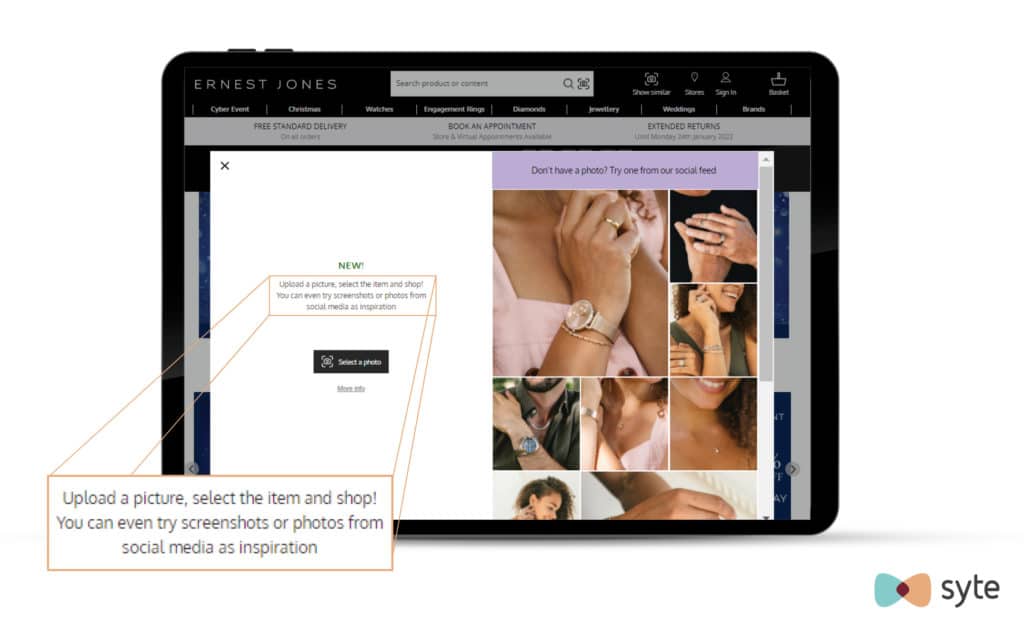
Innovative brands and retailers have been early adopters of visual search because they understand the impact this capability has for both shoppers and retailers. For example, here are three of the top benefits:
- Enhanced product discovery — Enabling shoppers to effortlessly find the products they are looking for makes product discovery more intuitive, engaging, and inspiring. For example, a shopper who knows exactly what she wants can simply upload a photo to the visual search tool and see all of your similar merchandise. To motivate casual browsers, you can use inspiration galleries to pique their interest. When a specific item stands out, shoppers can then easily identify similar products using your visual search feature.
- Omnichannel experience support — Visual search allows shoppers to seamlessly pivot from social media to your store. It allows them to act in the moment of inspiration—right when they see an image that catches their eye—and find hyper-relevant inventory without having to type a single word into the search box. This is especially beneficial for younger shoppers, who are more likely to impulse-buy. Compared to older Millennials, nearly 60% more Gen Z’ers have said they made a purchase after randomly seeing an item they liked, according to Accenture.
- Higher on-site conversion rate and revenue — In our “State of eCommerce Discovery” report, we found that shoppers who engage with visual search tools convert 840.6% more than shoppers who don’t use the tools and they spend on average 6.7x more per session, bringing in 451.2% higher average revenue per user than non-users. These impressive numbers are due to the precision of results that visual search produces. Irrelevant search results are unlikely, since the visual AI engine will only display SKUs that are visually similar to the item in the image.
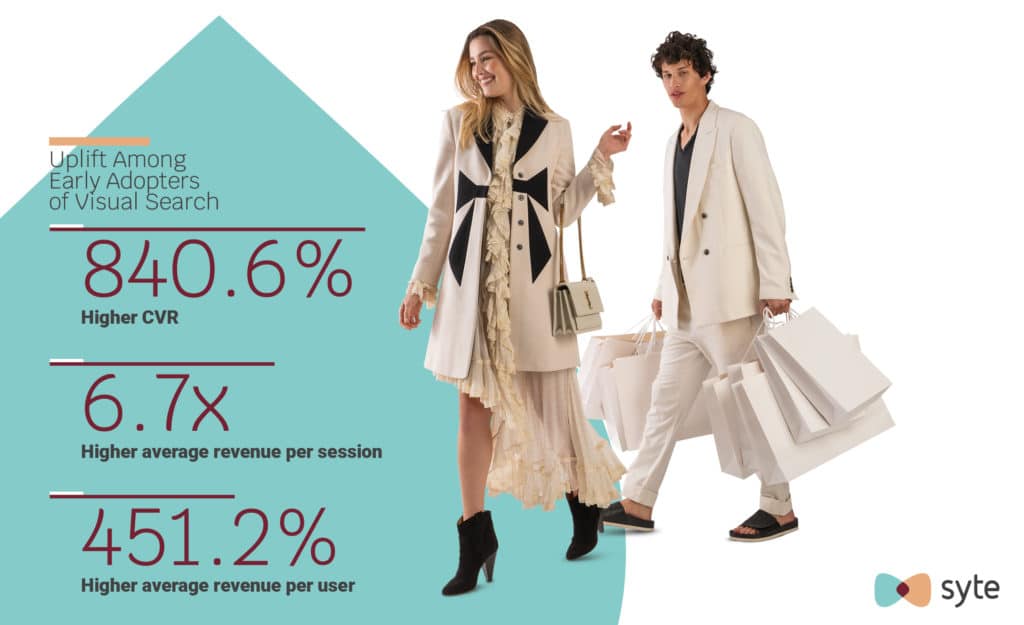
2. Improve the accuracy of text search
Visual AI also improves the text search experience by ensuring search results are relevant and accurate. Unlike conventional on-site search tools, which are not built to decipher intent, search term priority, or typos, enhanced textual search capabilities that rely on visual AI can actually intuit what your shoppers are looking for.
Here’s how it works: Once your visual AI engine scans all of the images in your product catalogue, it automatically creates comprehensive tags and metadata for each item that encompass every possible product descriptor and its synonyms. This process is called deep tagging.
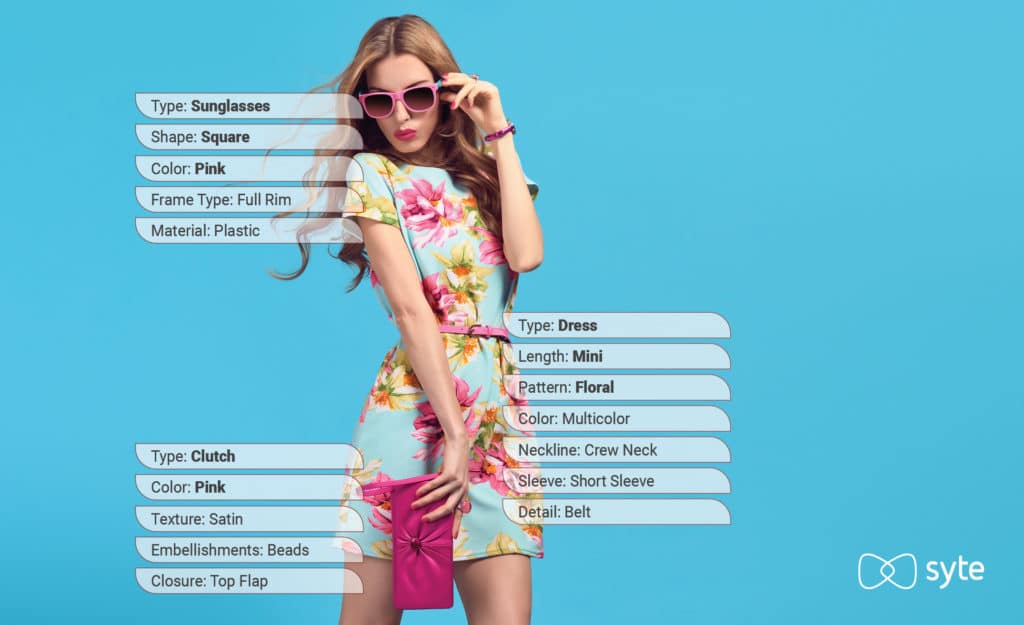
Advanced search tools like Augmented Site Search combine visual AI and natural language processing (NLP) technology during the search itself. Once a shopper inputs a query, NLP allows your search engine to accurately intuit what he or she means. It works by deciphering human context and intent in order to deliver results that most closely match the original query. For example, while a conventional search engine might not understand what I mean by “tight low neck dress knee length black,” Augmented Site Search will know that I want to see results for black, midi, scoop neck, bodycon dresses.
In comparison, manually tagging products with this level of comprehensiveness and standardization isn’t possible at scale. For companies that add hundreds or thousands of new SKUs a week, attempting to do this manually is time-and-resource-intensive.
Relying solely on manual tagging also limits your ability to add dynamic search filters to your site. When you have a comprehensive set of deep tags generated by visual AI, you can add dynamic filters that only appear for certain products and categories and not others. Dynamic filters are added automatically as a result of the visual AI flow and allow you to go beyond generic filter options like brand, size, and color. For example, your site can auto-populate dynamic filters for patterns or embellishments if that’s relevant in the moment. This can be extremely useful to shoppers who want to further narrow the results of their original text query and hone in on just the right item.
The end result with visual AI is an effortless search experience that quickly connects shoppers to the right products. It eliminates the frustration of “No Results” pages, and makes sure shoppers don’t need to sift through dozens of rows of irrelevant items before finding what they want (if they don’t drop off first).
3. Enable more strategic online merchandising
With visual AI at the core of your eCommerce infrastructure, you can enhance product tags at scale. This is the fundamental first step to optimizing all of your merchandising activities, from creating collections to producing personalized search results and product recommendations.
After you’ve developed a strong foundation of robust, standardized, and objective product tags, you can perform smart merchandising activities that enable you to optimize a variety of metrics in order to create more compelling shopping experiences that strategically boost conversion alongside your unique business goals.
For example, you can set rules to display items with high margins at the top of your search results or recommendation carousels, or if you have items that you need to get rid of from last season, you can make sure those products appear first.
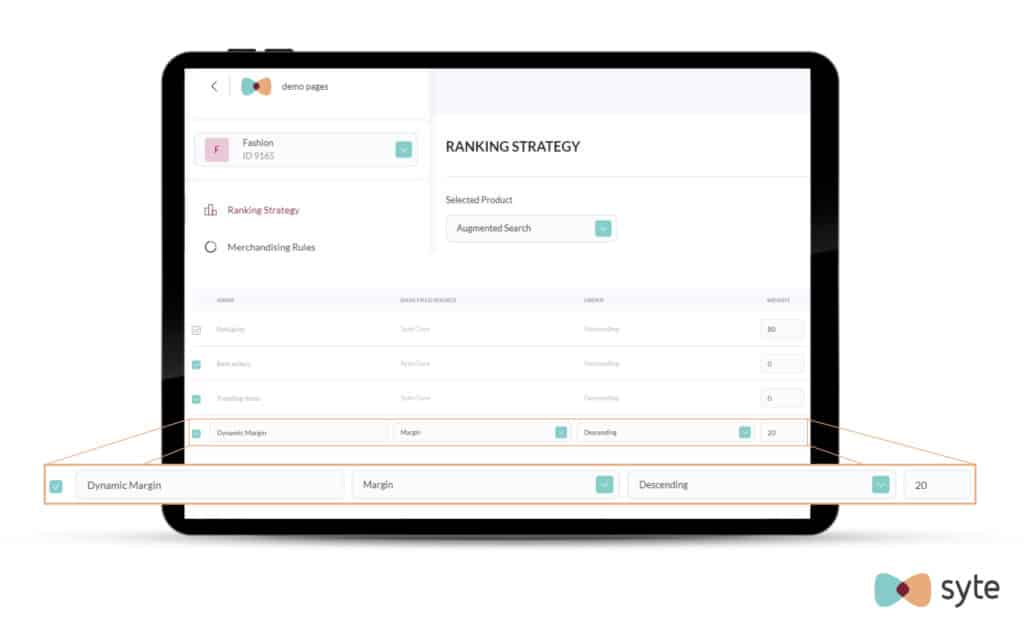
Smart merchandising rules can relate to product category, amount of stock, brand, profit margin, customer ratings and reviews, how long the item has been in your inventory, and more. This kind of strategizing allows you to customize, test, and control the customer journey.
From the customer perspective, smart merchandising makes sure shoppers always view the products that are most relevant to them. On the business side, you can use smart merchandising to ensure that every item on-screen helps you achieve your business goals, whether that’s moving more inventory faster, raising profit margins, promoting your newest collection, or any number of other internal priorities.
4. Provide true personalization
Without visual AI, it’s virtually impossible to provide a truly personalized customer experience. Conventional personalization engines rely on statistical algorithms that are based on the shopping history data of thousands of other customers. As a result, the product recommendations it produces are really predictions based on statistics, and not the unique traits (like taste and style) of individual shoppers.
Instead of calling it personalization, it would be more accurate to call this approach segmentation. Ultimately shoppers who fit into a certain category will receive generic recommendations for products that other shoppers in the same category received. For example, if you are a 35-year-old woman from New Orleans and you click on a purple sundress, you will start receiving recommendations for products purchased by other 35-year-old women from New Orleans who also bought that dress.
The other main consequence of this generic approach to personalization is that it creates a cycle that reinforces the success of certain items in the algorithm over others just because they get more exposure. In turn, the same products keep getting recommended, while never-before-purchased items don’t, even if those would be the most relevant recommendation for a specific shopper.
If you want to provide true personalization, segmentation isn’t enough. Instead, visual AI is the key to creating hyper-personalized shopping experiences. It works by analyzing the details in the images of products that shoppers interact with, enabling brands and retailers to truly understand and respond to each shopper’s unique style and intention. Visual AI doesn’t replace statistical algorithms, it adds essential capabilities to them. This combination helps you understand what’s popular to others, but maintain the ability to identify items that best meet the needs of each individual shopper.
Visual AI is also context-sensitive, meaning it is equipped to keep up with changing moods and needs in order to “realize” when a shopper’s goal has changed. For example, if you start your customer journey by searching for a bikini for your upcoming vacation, but then later look for a birthday gift for your father-in-law, visual AI-enabled recommendations will have the ability to sense that your goal has changed. Instead of continuing to recommend swimsuits, it will begin recommending items that support your new intention.

5. More accurate trend forecasting
Visual AI engines produce a wealth of data, much of which can be used to optimize your supply chain and boost operational efficiency. With granular insights into what kinds of styles shoppers are interested in (and what they’re not), you can more accurately predict customer trends.
For example, it may be easy to assume that high-waisted jeans are trending, and that you should increase your inventory. But with the granular insights enabled by visual AI, you can uncover that specifically, medium wash high-waisted jeans with a visible button-up closure perform the best, while skinny leg high-waisted jeans perform the worst.
Integrating this data into your supply chain and inventory management systems allows you to make more strategic decisions on what kinds of styles and products to offer, as well as inventory volumes to carry. By stocking your inventory accordingly, you will be positioned to reduce unmoving inventory and boost profits.
6. Reduce waste
Another important benefit of data generated by visual AI is that you can use it to reduce your environmental impact and appeal to values-driven shoppers, or consumers who want the companies they buy from to make greater efforts to become sustainable and be transparent about their environmental impact.
According to McKinsey, 88% of consumers think retailers should take more action to reduce pollution, while 63% say a brand’s promotion of sustainability is a significant purchasing factor.
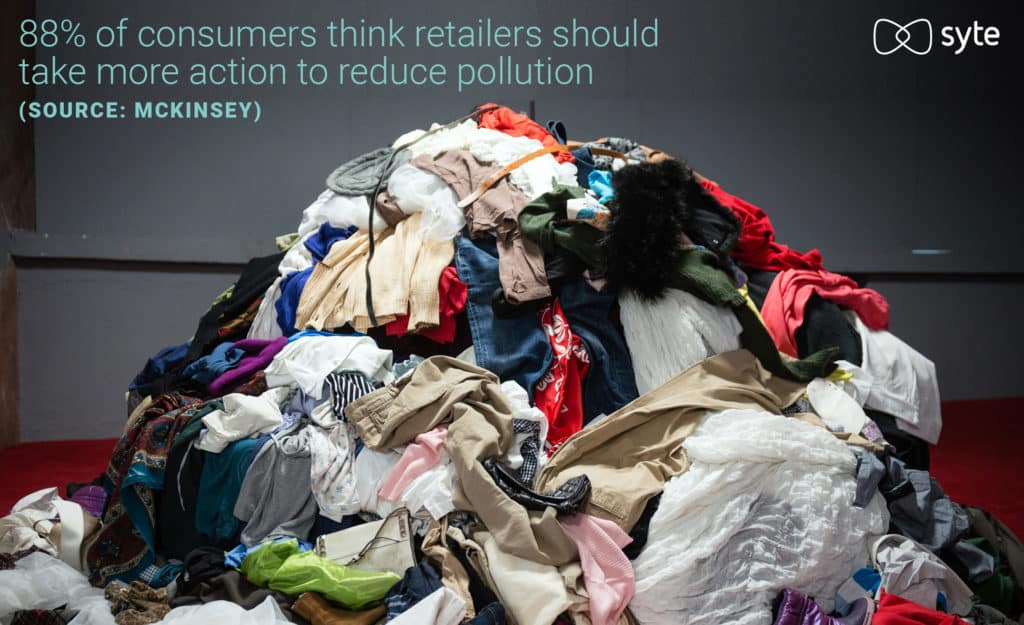
With a precise, data-driven approach to managing your inventory and logistics, it’s easier to reduce waste while also lowering the costs of warehousing inventory surpluses. Detailed and customer-centric data can be used to inform your buying strategy so that you don’t over-order items that won’t sell, that require prolonged warehousing, or that will ultimately get thrown out.
Unlock Your eCommerce Potential With Visual AI
In a saturated and competitive digital landscape, eCommerce success requires an innovative and advanced underlying infrastructure. Visual AI, with its invaluable data and wide range of capabilities, empowers brands and retailers to provide a distinctive customer experience, master merchandising, improve inventory management, and reduce waste.
By integrating visual AI into your eCommerce infrastructure, you will gain the insights and capabilities you need to stand out and thrive.